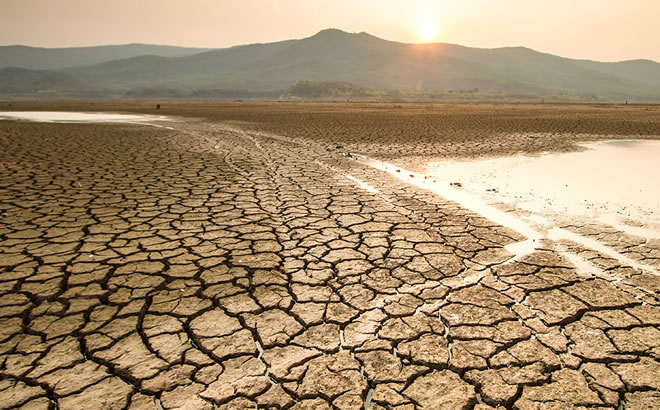by Volkan Bozkir
Tuesday, May 11, 2021

What do you think of when you hear the word “desertification”? Sand dunes slowly encroaching on bountiful farmland? The Sahara and Gobi taking over Africa and Asia? Rivers and streams drying up? That’s certainly part of it. But the key impact of desertification is the degradation of land – to the point where soil becomes so damaged that it no longer supports life.
Soil is so much more than dirt. And healthy soil is essential to a healthy planet. The ground beneath our feet is teeming with a hidden world of plants, animals and microbes – many too tiny to see. But our survival depends on them. This overlooked reservoir feeds our agriculture and food industries. It helps to regulate greenhouse gas emissions and keeps plants, animals and humans strong.
But today, more than one fifth of the planet’s land – including more than half of our agricultural land – is suffering. Each year, more than 12 million hectares of land are lost to desertification, land degradation and drought. This loss hurts over 3 billion people, particularly poor and rural communities in the developing world. At the same time, when land is hastily converted to cropland, without considering the overall health of our environment, then carbon and nitrous oxide are released into the atmosphere. Climate change accelerates, biodiversity withers and infectious diseases blossom. This all jeopardizes water supplies, livelihoods and our ability to face natural disasters and extreme weather events.
Unless we act now, it’s only going to get worse. Over the next 25 years, land degradation could reduce global food productivity by as much as 12%, leading to a 30% increase in world food prices. We will never achieve the Sustainable Development Goals if we remain complacent.
But there is much to be hopeful about – and much that we can achieve together. As we have seen with the rapid development of COVID-19 vaccines, when the will is there and resources are deployed, humankind can achieve truly astounding feats.
Restoring 350 million hectares of degraded land by 2030 could take between 13 and 26 gigatons of greenhouse gases out of the atmosphere. For every dollar spent on land restoration – including through low-skilled and labour-intensive projects – at least 9 dollars of economic benefits can be expected. Restoring land not only generates green job opportunities across a wide range of industries – but will also enable us to grow more nutritious food, provide clean water security, address biodiversity loss, and mitigate and adapt to climate change.
Whether we’re talking about city dwellers, who need reliable supplies of fruits and vegetables, or island hoteliers, who count on protected beaches and swaying palm trees to draw in tourists, or hospital patients, whose lives depend on nature-derived medicines, one thing is clear. There is no person on earth – or for that matter any being – whose existence is not tied to land.
So, what can you do to help protect our land and soil? One simple step is not to waste food – because when farmers work the land to produce food we’re not eating, that just exhausts our soil unnecessarily. And if you’re an urbanite, you can work with your local officials to make your city greener – through such innovative methods as rooftop gardens and vertical forests.
Here at the United Nations, promoting land regeneration is a critical part of our work. In the coming months, major conferences to follow up on the three Rio Conventions – the UN Convention to Combat Desertification (UNCCD), UN Framework Convention on Climate Change (UNFCCC) and Convention on Biological Diversity (CBD) – will all be held during the same year for the first time ever. This a unique opportunity to reflect on the health of our planet – and on what we can do to improve it and protect our very existence.
For my part, on 20 May, I will host a high-level meeting on desertification, land degradation and drought, in the iconic United Nations General Assembly Hall in New York. This meeting – the first of its kind in more than a decade – will build on previous achievements, highlight gaps in our collective efforts and spur momentum towards the three big Rio-related conferences. It will remind us that land degradation is real and needs to be fought. It will show how three seemingly different issues – climate, biodiversity and desertification – are actually intrinsically linked. And it will drive up ambition for global action.
The General Assembly is the only body where all 193 Member States of the United Nations sit as equals. So, there is no better place to tackle the problems that transcend borders and affect us all. When it comes to the very earth we stand on – the life-giving soil that sustains us – there is no time to waste. High-level conferences may not improve the situation overnight. But in making sure we’re all on the same page, sharing best practices and taking real steps together, we can change course. Ultimately, we will reverse desertification, land degradation and drought – because there is no other choice. But we will need to work together. We will need to change some of our practices. And I hope the United Nations can count on your support.
Learn more at: www.un.org/pga/75/event/high-level-dialogue-on-desertification-land-degradation-and-drought/
Volkan Bozkir is the 75th President of UN General Assembly at United Nations